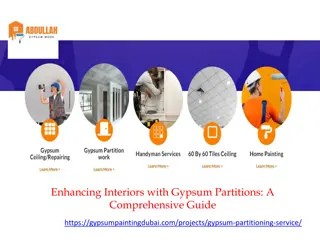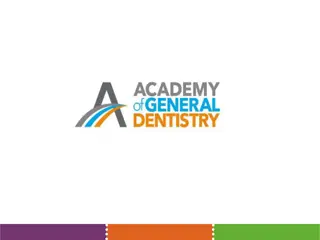Understanding Gypsum Products in Dentistry
Gypsum products play a crucial role in dentistry, serving as impression materials, die materials, and models. The classification of gypsum products includes impression plaster, model plaster, dental stone, and high-strength variations. The manufacturing process varies for dental plaster and stone, with beta and alpha forms of calcium sulfate hemihydrate involved. Furthermore, the setting of gypsum products involves theories such as the colloidal theory, hydration theory, and dissolution-precipitation theory. These products are essential for creating accurate dental replicas and structures in prosthodontics.
Download Presentation

Please find below an Image/Link to download the presentation.
The content on the website is provided AS IS for your information and personal use only. It may not be sold, licensed, or shared on other websites without obtaining consent from the author. Download presentation by click this link. If you encounter any issues during the download, it is possible that the publisher has removed the file from their server.
E N D
Presentation Transcript
CONTENTS INTRODUCTION MODELS Gypsum products Classification of gypsum products Properties Manipulation DIE MATERIALS Types of die materials Compatibility with impression materials CONCLUSION
INTRODUCTION MODEL: A fascimile used for display purposes; A positive likeness of an object. DIE: The positive reproduction of the form of a prepared tooth in any suitable substance. Glossary of prosthodontic terms
GYPSUM PRODUCTS Gypsum is a mineral mined in various parts of the world. It is produced as a by-product of some chemical processing operations. It is obtained from natural rock. The dihydrate form of calcium sulfate is called GYPSUM. PHILIPS SCIENCE OF DENTAL MATERIALS ELEVENTH EDITION
TYPES OF GYPSUM PRODUCTS TYPE I - Impression plaster TYPE II - Model plaster TYPE III - Dental stone TYPE IV Dental stone ,Die , High strength TYPE V - Dental stone ,Die , High strength , High expansion PHILIPS SCIENCE OF DENTAL MATERIALS ELEVENTH EDITION
DENTAL PLASTER AND STONE PLASTER is beta form of calcium sulfate hemihydrate. STONE is an alphaform of calcium sulfate hemihydrate. Manufacturing of plaster and stone: plaster Produced by calcination process in open air. Dental stone produced by wet calcination. PHILIPS SCIENCE OF DENTAL MATERIALS ELEVENTH EDITION
Beta hemihydrate crystals Alpha hemihydrate crystals PHILIPS SCIENCE OF DENTAL MATERIALS ELEVENTH EDITION
TYPE IV AND TYPE V GYPSUM Alpha modified calcium sulfate hemihydrate. Also known as Densite. Manufactured by boiling gypsum in a 30% aqueous solution of calcium chloride and magnesium chloride.
SETTING OF GYPSUM PRODUCTS THEORIES OF SETTING REACTIONS: Colloidal theory Hydration theory Dissolution precipitation theory PHILIPS SCIENCE OF DENTAL MATERIALS ELEVENTH EDITION
WATER POWDER RATIO The amounts of water and hemihydrate should be gauged accurately by weight. The W/P ratio is an important factor in determining the physical and chemical properties of the final gypsum product PHILIPS SCIENCE OF DENTAL MATERIALS ELEVENTH EDITION
TEST FOR WORKING AND SETTING TIMES Loss of gloss test Initial Gillmore test for initial set Vicat test for setting time Gillmore test for final set PHILIPS SCIENCE OF DENTAL MATERIALS ELEVENTH EDITION
RETARDERS AND ACCELATORS Setting time can be controlled by addition of certain chemical modifiers. Retarders are borax, potassium citrate, and sodium chloride (20%)(ABC) Accelerators are gypsum (<20%),Pottasium sulfate, sodium chloride (<28%),Terra alba.
SETTING EXPANSION An expansion of the mass can be detected during the change from the hemihydrate to the dihydrate. Depending on the composition of the gypsum product, this observed linear expansion may be as low as 0.06% or as high as 0.5%.
NORMAL SETTING EXPANSION PHILIPS SCIENCE OF DENTAL MATERIALS ELEVENTH EDITION
HYGROSCOPIC SETTING EXPANSION PHILIPS SCIENCE OF DENTAL MATERIALS ELEVENTH EDITION
STRENGTH The strength of gypsum products is generally expressed in terms of compressive strength. The free-water content of the set product definitely affects its strength. Two strength properties of gypsum are reported: the wet strength (also known as green strength) and the dry strength PHILIPS SCIENCE OF DENTAL MATERIALS ELEVENTH EDITION
MANIPULATION The preferred method of mixing is to add the measured water first, followed by gradual addition of the preweighed powder. 'I'he powder is incorporated during approximately 15 sec of mixing with a hand spatula, followed by 20 to 30 sec of mechanical mixing under vacuum. A longer spatulation time reduces the working time particularly for pouring models. CRAIGS RESTOATIVE DENTAL MATERIALS
INVESTMENTS A ceramic material that is suitable for forming a mold into which a metal or alloy is cast. It is a mixture of three distinct type of materials Refractory material Binder material Other chemicals CRAIGS RESTOATIVE DENTAL MATERIALS
TYPES OF INVESTMENTS Gypsum bonded investments Phosphate bonded investments Ethyl Silicate bonded investments
GYPSUM BONDED INVESTMENTS Supplied as fine powder. Refractory : cristoballite , quartz Binder: type III dental stone. Modifiers: k, Li,Na chlorides or boric acid Reducing agents : copper,graphite Small amount of color CRAIGS RESTOATIVE DENTAL MATERIALS
PHOSPHATE BONDED INVESTMENTS Supplied in sealed sachets weighing 200-500gms Used with high fusing alloys Refractory : cristoballite or quartz Binder : mixture of basic MgO and acidic NH4H2PO4 Small amounts of carbon LIQUID: colloidal silica suspension CRAIGS RESTOATIVE DENTAL MATERIALS
ETHYL SILICATE BONDED INVESTMENTS Developed to meet the refractory requirements of high fusing PBM alloys. It is supplied as a powder of quartz or crystoballite. Setting and bonding mechanisms are more complex. Green shrinkage occurs when water and alcohols escape. CRAIGS RESTOATIVE DENTAL MATERIALS
DIE MATERIALS USED GYPSUM PRODUCTS: Type IV Dental stone Type V Dental stone DIE STONE INVESTMENT COMBINATION ELECTROFORMED DIES: Silver plated Copper plated EPOXY RESINS POLYURETHANE DIES AMALGAM DIES METAL SPRAYED DIES FLEXIBLE DIE MATERIALS REFRACTORY DIES SILICOPHOSPHATE DIES CERAMIC DIES
GYPSUM DIES Commonly type IV and type V gypsum used.
DIE STONE INVESTMENT COMBINATION Commercially available gypsum bonded materials. The divestment is mixed with colloidal silica and liquid. Die is made and wax pattern is constructed on it. Then the whole complex is invested in a mixture of divestment and water.
ELECTROFORMED DIES It is done to improve the abrasive resistance of the die material. Metalizing agents like graphite , copper powder or silver dust - suspension is coated over the impression for electrical conduction CONTEMPORARY FIXED PROSTHODONTICS ROSENTIAL.LAND.FUJIMOTO
COPPER PLATING COPPER PLATED DIES compound or addition silicone impression materials. COMPOSITION: Copper sulfate Sulfuric acid Alcohol or phenol TORESKOG PHILIPS SV,SCHENELL RJ,PROPERTIES OF DIE MATERIALS : A COMPARATIVE STUDY JOURNAL OF PROSTHETIC DENTISTRY 1966 Pg 119
SILVER PLATING For polyether , polysulfide and silicone rubber base impression materials. COMPOSITION: Silver cyanide potassium cyanide silver or graphite.
EPOXY RESIN DIES Highly viscous liquids(sometimes solid) on polymerising with amines , polysulfides or polyamides hard epoxy resin die can be obtained. CONTEMPORARY FIXED PROSTHODONTICS ROSENTIAL.LAND.FUJIMOTO
Epoxy resin exhibits better detail reproduction, abrasion resistance and transverse strength than the gypsum products. The setting shrinkage compared with the expansion observed with gypsum die materials may require modifications in technique to obtain castings that will be well adapted to the tooth preparation . Philip Duke,B.K.Moore ,Steven Phaug and Carle J Andres .Study of the physical properties Of type IV gypsum ,resin containing and epoxy die material journal of prosthetic dentistry 2000 ; 83; 466-473
POLYURETHANE DIES Most accurate , strongest and cleanest die material. Superior mechanical properties. Water resistant. DERRIEN G,STURTZ G COMPARISON OF TRANSVERSE STRENGTH AND DIMENSIONAL VARIATION ODF DIE STONE , EPOXY RESIN AND POLYURETHANE RESIN JOURNAL OF PROSTHETIC DENTISTRY 1996 569-574
AMALGAM DIES This is similar to a restorative material. E.C.COMBE NOTES ON DENTAL MATERIALS
METAL SPRAYED DIES A bismuth- tin alloy is used. ADVANTAGES: It can be rapidly obtained from impression materials. DISADVANTAGES: Alloy is soft it will tend to abrade. E.C.COMBE NOTES ON DENTAL MATERIALS
FLEXIBLE DIE MATERIALS Similar to heavy bodied silicone or polyether impression materials CONTEMPORARY FIXED PROSTHODONTICS ROSENTIAL.LAND.FUJIMOTO
REFRACTORY DIES Made for preparation of all ceramic restorations Excellent marginal adaptation.
SILICOPHOSPHATE DIES Similar to the filling and cementing material. E.C.COMBE NOTES ON DENTAL MATERIALS
COMPATIBILITY WITH IMPRESSION MATERIALS DIE STONE Impression compound, zinc oxide eugenol , alginate , impression plaster and rubber base impression material. ELECTROPLATED COPPER Impression compound ELECTROPLATED SILVER - polysulphide , rubber base material. EPOXY RESIN - Rubber base impression material.
CONCLUSION Good impression and die fabrication with selection of the die material and its manipulation paramount to achieve accuracy in the final restoration.























